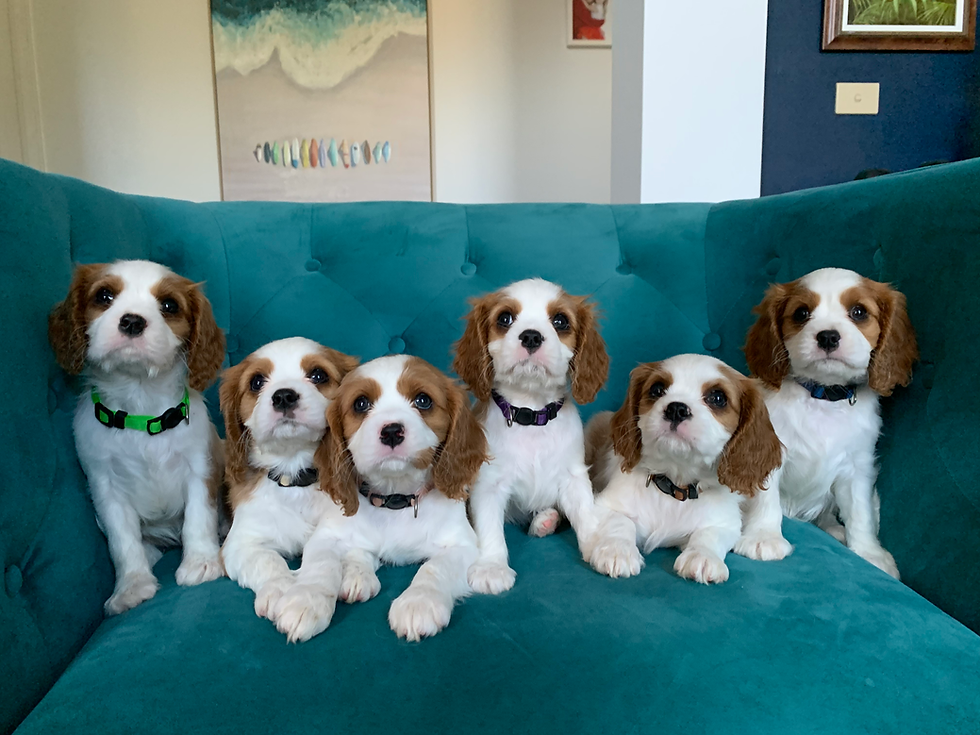La Rose Cavalier Breeding Standards for Responsible Breeders
- Shelley Tilbrook
- May 6
- 2 min read
Updated: Jul 27
When breeding Cavalier King Charles Spaniels, at La Rose Cavaliers, we strive for pawfection as responsible breeders with our focus on health, temperament, and conformation to breed standards.

Here's an outline of the most important traits we prioritise:
1. Health (Top Priority)
Cavaliers are prone to several inherited health issues, so testing and selecting breeding dogs based on clear health results is crucial:
Mitral Valve Disease (MVD): A common and serious heart issue; avoid breeding dogs before age 2. Ideal breeders use older, MVD-clear lines.
Syringomyelia (SM): A neurological condition; MRI screening helps reduce risk.
Eye conditions: Including cataracts and retinal problems — screen annually.
Hip Dysplasia: Ensure proper hip grading (via OFA or similar).
Patellar Luxation: Test for joint issues in the knees.
Episodic Falling Syndrome and Curly Coat/Dry Eye: DNA tests are available.
All our breeding dogs are screened for these common health conditions through our vet and also with Orivet testing to ensure compatability and no genetic diseases are passed on to the pups. We also chose Bently from Prestige Dog Services as the Sire due to his rare AG gene which prevents MVD.
🧠 2. Temperament
Cavaliers are known for their affectionate, gentle, and sociable nature. Breeding dogs should have:
Friendly, trusting temperaments
Low aggression
Good behaviour around children and other pets
Our dogs are well socialised and well trained and our pups are raised using the Puppy Culture training protocols.
🐶 3. Conformation to Breed Standard
Maintaining physical traits as defined by breed clubs (like AKC, UKC, or The Kennel Club):
Size: 12–13 inches tall, 13–18 lbs
Head: Slightly rounded with a well-tapered muzzle
Eyes: Large, dark, round (not prominent)
Coat: Silky, moderate length, with feathering
Colour: Four recognised types (Blenheim, Tricolor, Ruby, Black & Tan)
We are currently breeding Blenheim Cavaliers and hope to add further colours to our breeding program in the future.
4. Pedigree and Genetic Diversity
Avoid inbreeding and line-breeding that concentrates risk of disease
Use Coefficient of Inbreeding (COI) calculators to maintain genetic diversity
With our genetic screening we ensure genetic diversity and understanding the pedigree ensures diversity of lines.
✅ Best Practices for Breeding:
We only breed Cavaliers that are fully health-tested and cleared.
We wait until dogs are at least 2 years old, with no signs of MVD.
Work with a mentor or breeding club to improve the breed ethically.
Keep lifetime responsibility for the puppies (rehome if needed, ensure ethical placements).
La Rose Cavaliers is a member of the Responsible Pet Breeders Association and follow all ethical breeding standards set and more to ensure breed longevity, health anfd temperament.



















Comments